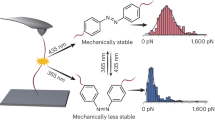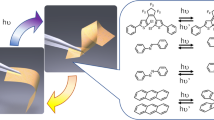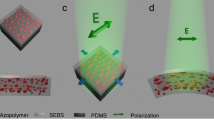Abstract
The switching or isomerization speed of photochromic dyes in a rigid polymeric matrix (such as an ophthalmic lens) is generally significantly slower than that observed in the mobile environment of a solution. Here we describe that the attachment of flexible oligomers having a low glass-transition temperature—such as poly(dimethylsiloxane)—to photochromic dyes greatly increases their switching speeds in a rigid polymer matrix. The greatest impact was observed in the thermal fade parameters T1/2 and T3/4—the times it takes for the optical density to reduce by half and three quarters of the initial optical density of the coloured state—which were reduced by 40–95% and 60–99% respectively for spirooxazines, chromenes and an azo dye in a host polymer with a glass-transition temperature of 120 °C. The method does not alter the electronic nature of the dyes but simply protects them from the host matrix and provides greater molecular mobility for the switching process. In addition to ophthalmic lenses, the generic nature of the method may find further utility in data recording or optical switching.
This is a preview of subscription content, access via your institution
Access options
Subscribe to this journal
Receive 12 print issues and online access
$259.00 per year
only $21.58 per issue
Buy this article
- Purchase on Springer Link
- Instant access to full article PDF
Prices may be subject to local taxes which are calculated during checkout




Similar content being viewed by others
References
Bouas-Laurent, H. & Durr, H. Organic photochromism. Pure Appl. Chem. 73, 639–665 (2001).
Kawata, S. & Kawata, Y. Three-dimensional optical storage using photochromic materials. Chem. Rev. 100, 1777–1788 (2000).
Yokoyama, Y. Fulgides for memories and switches. Chem. Rev. 100, 1717–1739 (2000).
Irie, M. Diarylethenes for memories and switches. Chem. Rev. 100, 1685–1716 (2000).
Berkovic, G., Krongauz, V. & Weiss, V. Spiropyrans and spirooxazines for memories and switches. Chem. Rev. 100, 1741–1753 (2000).
Delaire, J. A. & Nakatani, K. Linear and nonlinear optical properties of photochromic molecules and materials. Chem. Rev. 100, 1817–1845 (2000).
Higgins, S. Chasing a rainbow. Chem. Brit. June, 26–29 (2003).
Feringa, B. L. (ed.) Molecular Switches (Wiley-VCH, Weinheim, 2001).
Guglielmetti, R. in Photochromism - Molecules and Systems, Studies in Organic Chemistry Vol. 40 (eds Dürr, H. & Bous-Laurent, H.) 314–455 (Elsevier Science, Amsterdam, 1990).
Such, G. K., Evans, R. A, Yee, L. H. & Davis, T. P. Factors influencing photochromism of spiro - compounds within polymeric matrices. J. Macromol. Sci. C 43, 547–579 (2003).
Krongauz, V. A. in Photochromism: Molecules and Systems Vol. 40 1st edn (eds Dürr, H. & Bous-Laurent, H.) 793–820 (Elsevier Science, Amsterdam; 1990).
Langer, R. Drug delivery and targeting. Nature 392 (suppl. 30 April), 5–10 (1998).
Hermanson, G. T. Bioconjugate Techniques 606–618 (Academic, San Diego, 1996)
Allen, T. M. & Cullis, P. R. Drug delivery systems: entering the mainstream. Science 303, 1818–1822 (2004).
Kakishita, T., Matsumoto, K. & Kiyotsukuri, T. Synthesis and NMR study of 9'-substituted spiroindolinonapthoxazine Derivatives. J. Heterocyclic Chem. 29, 1709–1715 (1992).
Shagina, L., Buchholz, F., Yitzchaik, S. & Krongauz, V. Searching for photochromic liquid crystals. Liq. Cryst. 7, 643–655 (1990).
Corns, S. N. et al. Neutral coloring photochromic 2H-naphtho[1,2-b] pyrans and heterocyclic pyrans. US Patent 6,248,264 B241 (2001).
Evans, R. A. et al. Photochromic compositions and light transmissible articles. World patent WO 2004/041961; PCT/AU03/01453 (2003).
Walters, R. W. & Van Gemert, B. Hydroxylated/carboxylated naphthopyrans. World patent WO 2001/70719 A2; PCT/US01/05881 (2001).
Schaudel, B., Guermeur, C., Sanchez, C., Nakatani, K. & Delaire, J. A. Spirooxazine- and spiropyran-doped hybrid organic-inorganic matrixes with very fast photochromic responses. J. Mater. Chem. 7, 61–65 (1997).
Hobley, J. et al. Ultrafast photo-dynamics of a reversible photochromic spiropyran. J. Phys. Chem. A 106, 2265–2270 (2002).
Hu, A. T., Wang, W.-H. & Lee, H.-J. Photochromism of spirooxazine doped or bonded in polymer matrixes. J. Macromol. Sci. A 33, 803–810 (1996).
Nakamura, S., Uchida, K., Murakami, A. & Irie, M. Ab initio MO and proton NMR NOE studies of photochromic spironaphthoxazine. J. Org. Chem. 58, 5543–5545 (1993).
Maeda, S., Mitsuhashi, K., Osano, Y. T., Nakamura, S. & Ito, M. The molecular design and applications of spirooxazines. Mol. Cryst. Liq. Cryst. A 246, 223–230 (1994).
Geftakis, S. & Ball, G. E. Direct observation of a transition metal alkane complex, CpRe(CO)2(cyclopentane), using NMR spectroscopy. J. Am. Chem. Soc. 120, 9953–9954 (1998).
Acknowledgements
We acknowledge the Cooperative Research Centre for Polymers for funding and the Australian Research Council for the award of an Australian Professorial Fellowship to T.P.D.
Author information
Authors and Affiliations
Corresponding author
Ethics declarations
Competing interests
The authors declare no competing financial interests.
Supplementary information
Supplementary Information
Supplementary Material A, B, C, D and E (PDF 200 kb)
Rights and permissions
About this article
Cite this article
Evans, R., Hanley, T., Skidmore, M. et al. The generic enhancement of photochromic dye switching speeds in a rigid polymer matrix. Nature Mater 4, 249–253 (2005). https://doi.org/10.1038/nmat1326
Received:
Accepted:
Published:
Issue Date:
DOI: https://doi.org/10.1038/nmat1326
This article is cited by
-
Constructing on-demand single/multi-color transitioning fabrics with photocatalysis/photothermal-armed deficient semiconductors
Nano Research (2023)
-
Photosensitivity Enhancement of Spiropyran-Containing Functional Molecules by Introducing Flexible Spacers and Their Application in Smart Color-Changing Textiles
Fibers and Polymers (2023)
-
Color Performance, Durability and Handle of Inkjet-Printed and UV-Cured Photochromic Textiles for Multi-Colored Applications
Fibers and Polymers (2019)
-
Light-induced mechanical response in crosslinked liquid-crystalline polymers with photoswitchable glass transition temperatures
Nature Communications (2018)
-
Influence of silyloxy substitution on the photochromic properties of diarylbenzo- and naphthopyrans \(^{\S }\) §
Journal of Chemical Sciences (2018)



